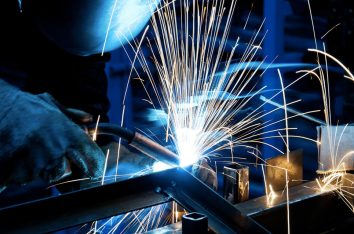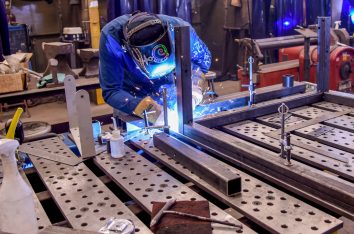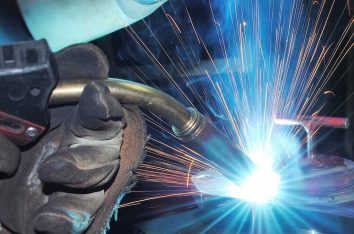Welding and fabrication workshops are environments that come with inherent risks. Whether you are a seasoned professional or a novice, adhering to safety protocols is crucial to ensure not only your own safety but also the safety of those around you. This article aims to provide a comprehensive guide on safety tips to maintain a secure and efficient workspace.
Key Takeaways
- Maintaining a clean and organized workspace can prevent accidents such as slips and falls.
- Using appropriate personal protective equipment (PPE) like respirators, gloves, and eye protection is essential.
- Proper handling and storage of materials, especially flammable and hazardous substances, is crucial for safety.
- Implementing fire safety measures such as installing fire suppression systems and conducting regular fire drills is vital.
- Regular training, education, and health monitoring can significantly reduce the risk of accidents and health issues.
Maintaining a Clean and Organized Workspace
Maintaining a clean and organized workspace is crucial for ensuring safety and efficiency in welding and fabrication workshops. A cluttered workspace can lead to injuries from welders tripping and falling, or worse, welding fires and explosions. Your workspace should only contain the tools and equipment you’re using for that specific project.
Preventing Slips and Falls
Keep the work area free of clutter, but make sure any necessary tools are easy to find. Store away unused cables and hoses to eliminate trip hazards. Additionally, gas cylinders must be chained securely to a stationary, upright support or cart.
Ensuring Adequate Lighting and Ventilation
Make sure the workshop is well-lit and has adequate ventilation. This means the fabrication process should follow a logical progression, from the way you bring raw material into the shop to how you store, cut, clean and prep. Proper lighting and ventilation are essential for maintaining a safe and efficient work area.
Installing Smoke Detectors and Fire Extinguishers
Install smoke detectors and fire extinguishers in the fabrication workshop. Regularly check these devices to ensure they are in working order. This is a critical step in building a safe foundation for your workspace.
Essential Personal Protective Equipment (PPE)
Personal protective equipment (PPE) is crucial in welding and fabrication workshops to safeguard workers from various hazards. Wearing the right PPE can significantly reduce the risk of injuries and illnesses. Below are the essential PPE items every worker should use:
Wearing Appropriate Respirators
Respirators are vital for protecting workers from inhaling harmful fumes and particles. Depending on the type of welding, different respirators may be required, such as disposable masks, powered air-purifying respirators, or supplied air respirators. It's important to follow OSHA guidelines and maintain a written respiratory protection program whenever a respirator is used.
Using Protective Clothing and Gloves
Welders should always dress in flame-resistant clothing to prevent burns and other injuries. This includes long-sleeved shirts, long pants with no cuffs, and specialized garments. Flame-resistant gloves are also essential to protect the hands from sparks and heat. Additionally, oil-resistant shoes and ear plugs or ear muffs for hearing protection should be worn.
Ensuring Eye and Face Protection
Eye protection is critical in welding to prevent injuries from sparks, debris, and intense light. Safety glasses or goggles should be worn at all times. A welding helmet with the appropriate shade filter is also necessary to protect the eyes and face from harmful radiation. Face shields can provide additional protection when performing tasks that generate flying particles.
Proper Handling and Storage of Materials
Handling and storing materials correctly in a welding and fabrication workshop is crucial for maintaining safety and efficiency. Metal fabrication materials are heavy and hazardous, so precautionary measures must be undertaken.
Safe Storage of Flammable Materials
Flammable materials should be stored in designated areas away from ignition sources. Use appropriate containers and ensure that these materials are clearly labeled. Regularly inspect storage areas for compliance with safety standards.
Handling Hazardous Substances
When dealing with hazardous substances, always use the right lifting equipment, such as hoists or cranes, to move heavy materials. Wear gloves while dealing with sharp materials and be cautious when cutting or drilling metal to avoid flying debris and sharp edges. Store materials in an organized fashion to prevent injuries and accidents.
Organizing Tools and Equipment
Proper organization of tools and equipment prevents clutter and ensures quick access when needed. Regular removal of unnecessary items from the workspace can significantly reduce the risk of accidents. Implement a system for organizing tools and materials to maintain a clean and efficient workspace.
Fire Safety Measures
Fire safety measures are essential in fabrication facilities to prevent and mitigate the effects of fires. Implementing measures such as fire alarms, sprinkler systems, and fire extinguishers can help contain fires and prevent damage. Regular inspections and training on fire safety procedures are also crucial for ensuring a safe working environment.
Installing Fire Suppression Systems
Fire suppression systems are essential in any welding and fabrication workshop. These systems can quickly extinguish fires, preventing them from spreading and causing significant damage. Installing these systems is a critical safety requirement to ensure the safety of both workers and equipment. Common fire suppression systems include sprinkler systems, fire extinguishers, and fire blankets.
Regular Fire Drills and Training
Conducting regular fire drills and training sessions is vital for preparing workers to respond effectively in case of a fire. These drills help familiarize employees with emergency exits, fire alarms, and the proper use of fire extinguishers. Regular training ensures that everyone is aware of the safety precautions and can act swiftly to minimize risks.
Safe Use of Welding Equipment
The welding process produces several heat sources that can easily ignite flammable materials. These heat sources include torch flames, sparks, spatter, and hot slag. To prevent fires, it is crucial to follow proper safety measures, such as maintaining a clean workspace and keeping flammable materials away from welding areas. Additionally, always adhere to the manufacturer's guidelines and safety standards when using welding equipment.
Electrical Safety Protocols
Electrical safety is paramount in welding and fabrication workshops to prevent accidents and injuries. Adhering to safety guidelines and protocols can significantly reduce the risk of electric shock and other electrical hazards.
Inspecting Electrical Equipment Regularly
Regular inspection of electrical equipment is crucial to ensure it is in good working condition. This includes checking for damaged cables, exposed wires, and faulty connections. Any defective equipment should be repaired or replaced immediately to avoid potential hazards.
Using Ground Fault Circuit Interrupters (GFCIs)
Ground Fault Circuit Interrupters (GFCIs) are essential devices that help prevent electric shock by cutting off the power supply when an imbalance is detected in the electrical current. Installing GFCIs in the workshop can provide an additional layer of protection for workers.
Avoiding Overloading Circuits
Overloading electrical circuits can lead to overheating and potential fire hazards. It is important to distribute the electrical load evenly and avoid using multiple high-power devices on a single circuit. Following the manufacturer's instructions and safety guidelines can help prevent circuit overloads and ensure a safe working environment.
Ventilation and Fume Control
Ensuring proper ventilation and fume control in a welding and fabrication workshop is crucial for maintaining a safe working environment. Welding processes can produce a variety of toxic fumes and gases that pose significant health risks if not adequately managed. Implementing effective fume mitigation strategies is essential to protect workers from exposure to harmful substances.
Installing Exhaust Hoods and Systems
Exhaust hoods and systems are vital for capturing and removing fumes and gases from the workspace. These systems should be strategically placed to ensure they effectively ventilate the area where welding activities occur. Regular maintenance and inspections are necessary to ensure these systems function correctly.
Using Portable Fume Extractors
Portable fume extractors offer flexibility and can be moved to different locations within the workshop as needed. These devices are particularly useful in areas where fixed exhaust systems are not feasible. They help in reducing the concentration of toxic fumes in the breathing zone of welders.
Ensuring Proper Airflow in the Workshop
Maintaining proper airflow is essential to prevent the accumulation of hazardous fumes and gases. This can be achieved by using fans, open windows, and other ventilation methods to promote air circulation. Adequate ventilation helps in dispersing fumes and maintaining a safe atmosphere for workers.
By implementing these measures, workshops can significantly reduce the risks associated with exposure to toxic fumes and ensure a safer working environment for all employees.
Training and Education
Training and education are vital components of a comprehensive safety program in fabrication facilities. Employees must be trained on safety procedures, equipment operation, and emergency response. Regular training sessions and refresher courses can help ensure that employees are equipped to handle various situations and maintain a safe working environment.
Understanding Safety Guidelines
A comprehensive understanding of safety guidelines is crucial for all personnel in a welding and fabrication workshop. Adhering to these guidelines ensures a safer working environment and minimizes the risk of accidents.
Regular Safety Workshops
Conducting regular safety workshops helps keep all employees updated on the latest safety protocols and practices. These workshops should cover various aspects of workshop safety, including the proper use of equipment and emergency procedures.
Certifications and Continuous Learning
Certifications play a vital role in validating the skills and knowledge of workers. For instance, the course provides an intensive overview of the skills necessary for a welder technician to perform the job, including lessons in math, inspection, and safety. Continuous learning opportunities should be encouraged to keep up with advancements in technology and safety standards.
Safe Handling of Welding Equipment
Safe handling of welding equipment is critical to prevent accidents and injuries. Fabricators must ensure that equipment is properly maintained, stored, and used. This includes wearing personal protective equipment, following safety guidelines, and monitoring equipment performance to prevent overheating or malfunction.
Receiving Appropriate Training
Proper training is the cornerstone of welding safety. All personnel involved in welding operations must undergo comprehensive training to understand the risks associated with welding and the correct procedures to mitigate them. This includes learning about different welding processes, the use of personal protective equipment (PPE), and emergency response actions.
Following Manufacturer Guidelines
Adhering to manufacturer guidelines is crucial for safe welding. Each piece of welding equipment comes with specific instructions that must be followed to ensure safe and efficient operation. This includes setting up the equipment correctly, using it within the recommended parameters, and performing regular maintenance as specified by the manufacturer.
Regular Maintenance and Inspections
Regular maintenance and inspections are vital to ensure the longevity and safe operation of welding equipment. Welders should routinely check their equipment for any signs of wear and tear, such as frayed cables or leaking hoses. Additionally, it's important to keep the welding area clean and organized to prevent accidents. Welding safety rules mandate that any defective equipment be repaired or replaced immediately to avoid potential hazards.
Emergency Preparedness
Emergency preparedness is crucial in fabrication facilities to ensure a rapid and effective response to emergencies. Developing an emergency response plan, conducting regular drills, and maintaining emergency equipment can help minimize damage and ensure the safety of employees and the public.
First Aid Training
First aid training is crucial in any welding and fabrication workshop. Employees must be trained to handle minor injuries and stabilize more serious ones until professional medical help arrives. This training should cover common injuries such as burns, cuts, and eye injuries.
Emergency Exits and Evacuation Plans
Ensure that guidelines and hazard signs are visible at all times. Emergency exits should be clearly marked and unobstructed. Regular drills should be conducted to familiarize employees with evacuation routes and procedures. This preparation can save lives in the event of a fire or other emergency.
Emergency Contact Information
Maintain an up-to-date list of emergency contact information. This list should include local emergency services, nearby hospitals, and key personnel within the company. Display this information prominently in the workshop so that it is easily accessible during an emergency.
Health Monitoring and Regular Checkups
Ensuring the health and well-being of workers in welding and fabrication workshops is paramount. Routine health screenings are essential to detect any early signs of health issues that may arise from prolonged exposure to hazardous materials and conditions. These screenings should be conducted regularly to monitor the overall health of the workforce.
Monitoring for respiratory issues is crucial, given the potential exposure to harmful fumes and particles. Implementing a medical surveillance program can help identify early signs of health effects related to weld fume exposure. This proactive approach ensures that any respiratory problems are addressed promptly.
Addressing ergonomic concerns is also vital in maintaining a healthy workforce. Workers should be educated on proper lifting techniques and provided with ergonomic tools and equipment to minimize the risk of musculoskeletal injuries. Regular assessments of the workplace can help identify and mitigate any ergonomic risks.
Hazard Communication
Effective hazard communication is essential in fabrication facilities to inform employees of potential hazards and ensure they take necessary precautions. This includes labeling hazardous materials, providing safety data sheets, and conducting regular training sessions on hazard recognition and mitigation.
Labeling Hazardous Materials
Proper labeling of hazardous materials is crucial in any welding and fabrication workshop. Ensure that guidelines and hazard signs are visible at all times. This practice helps in identifying potential hazards and taking necessary precautions. Labels should include information about the chemical's identity, the manufacturer's details, and appropriate hazard warnings.
Maintaining Safety Data Sheets (SDS)
The Occupational Safety and Health Administration (OSHA) requires that chemical manufacturers provide a Safety Data Sheet (SDS) for each hazardous chemical. These sheets contain essential information about the hazards in the workplace, including handling and storage instructions, emergency measures, and first-aid procedures. Employees must familiarize themselves with the SDS to understand the number of hazards associated with each material.
Conducting Regular Safety Meetings
Regular safety meetings are vital for reinforcing the importance of hazard communication. These meetings should cover various topics, such as new potential hazards, updates to OSHA regulations, and best practices for maintaining a safe work environment. Toolbox talks and other training sessions can be effective in keeping employees informed and vigilant about safety protocols.
Conclusion
In conclusion, maintaining a safe welding and fabrication workshop requires diligence, proper training, and adherence to established safety protocols. By keeping the workplace clean, well-lit, and ventilated, and by using appropriate personal protective equipment, many common hazards can be mitigated. Additionally, understanding and following safety guidelines, both from national organizations and manufacturers, is essential. Regular health checkups and the installation of safety devices like smoke detectors and fire extinguishers further contribute to a safer work environment. Ultimately, the key to preventing accidents and injuries lies in the continuous education and vigilance of everyone involved in the welding and fabrication process.
Recent Posts
- Where to Find High-Quality Fabrication and Welding in Oregon
- Where to Find High-Quality CNC Machining in Oregon
- CNC Machining Services by Ram-Z Fab: Precision and Innovation in Willamette Valley
- CNC Machining in the Automation Industry: Precision Engineering for the Future
- CNC Machining in the Food Production Industry: Precision for Palates




